The document discusses algorithms and data structures. It begins with an introduction to merge sort, solving recurrences, and the master theorem for analyzing divide-and-conquer algorithms. It then covers quicksort and heaps. The last part discusses heaps in more detail and provides an example heap representation as a complete binary tree.
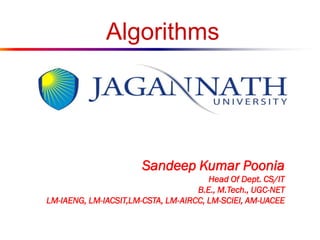

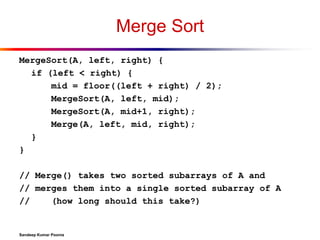
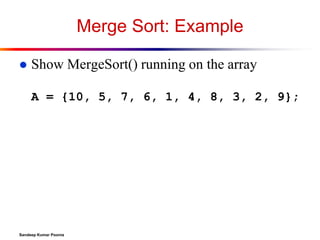








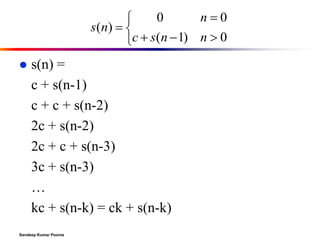














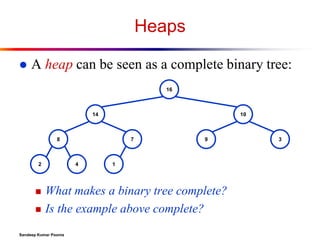


![Heaps
To represent a complete binary tree as an array:
The root node is A[1]
Node i is A[i]
The parent of node i is A[i/2] (note: integer divide)
The left child of node i is A[2i]
The right child of node i is A[2i + 1]
16
14
A = 16 14 10 8
7
9
3
2
4
8
1 =
2
Sandeep Kumar Poonia
10
7
4
1
9
3](https://image.slidesharecdn.com/recurrences-140217061838-phpapp01/85/Recurrences-31-320.jpg)

![The Heap Property
Heaps also satisfy the heap property:
A[Parent(i)] A[i]
for all nodes i > 1
In other words, the value of a node is at most the
value of its parent
Where is the largest element in a heap stored?
Definitions:
The height of a node in the tree = the number of
edges on the longest downward path to a leaf
The height of a tree = the height of its root
Sandeep Kumar Poonia](https://image.slidesharecdn.com/recurrences-140217061838-phpapp01/85/Recurrences-33-320.jpg)


![Heap Operations: Heapify()
Heapify(A, i)
{
l = Left(i); r = Right(i);
if (l <= heap_size(A) && A[l] > A[i])
largest = l;
else
largest = i;
if (r <= heap_size(A) && A[r] > A[largest])
largest = r;
if (largest != i)
Swap(A, i, largest);
Heapify(A, largest);
}
Sandeep Kumar Poonia](https://image.slidesharecdn.com/recurrences-140217061838-phpapp01/85/Recurrences-36-320.jpg)






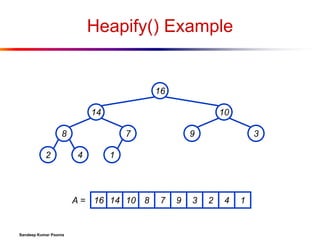
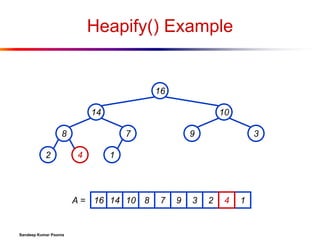




![Heap Operations: BuildHeap()
We can build a heap in a bottom-up manner by
running Heapify() on successive subarrays
Fact: for array of length n, all elements in range
A[n/2 + 1 .. n] are heaps (Why?)
So:
Walk
backwards through the array from n/2 to 1, calling
Heapify() on each node.
Order
of processing guarantees that the children of node
i are heaps when i is processed
Sandeep Kumar Poonia](https://image.slidesharecdn.com/recurrences-140217061838-phpapp01/85/Recurrences-49-320.jpg)
![BuildHeap()
// given an unsorted array A, make A a heap
BuildHeap(A)
{
heap_size(A) = length(A);
for (i = length[A]/2 downto 1)
Heapify(A, i);
}
Sandeep Kumar Poonia](https://image.slidesharecdn.com/recurrences-140217061838-phpapp01/85/Recurrences-50-320.jpg)



![Heapsort
Given BuildHeap(), an in-place sorting
algorithm is easily constructed:
Maximum element is at A[1]
Discard by swapping with element at A[n]
Decrement
heap_size[A]
A[n] now contains correct value
Restore heap property at A[1] by calling
Heapify()
Repeat, always swapping A[1] for A[heap_size(A)]
Sandeep Kumar Poonia](https://image.slidesharecdn.com/recurrences-140217061838-phpapp01/85/Recurrences-54-320.jpg)
![Heapsort
Heapsort(A)
{
BuildHeap(A);
for (i = length(A) downto 2)
{
Swap(A[1], A[i]);
heap_size(A) -= 1;
Heapify(A, 1);
}
}
Sandeep Kumar Poonia](https://image.slidesharecdn.com/recurrences-140217061838-phpapp01/85/Recurrences-55-320.jpg)





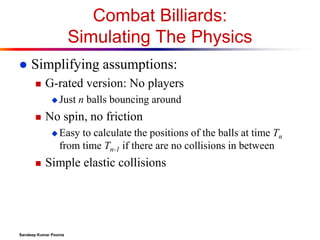

![Implementing Priority Queues
HeapInsert(A, key)
// what’s running time?
{
heap_size[A] ++;
i = heap_size[A];
while (i > 1 AND A[Parent(i)] < key)
{
A[i] = A[Parent(i)];
i = Parent(i);
}
A[i] = key;
}
Sandeep Kumar Poonia](https://image.slidesharecdn.com/recurrences-140217061838-phpapp01/85/Recurrences-63-320.jpg)
![Implementing Priority Queues
HeapMaximum(A)
{
// This one is really tricky:
return A[i];
}
Sandeep Kumar Poonia](https://image.slidesharecdn.com/recurrences-140217061838-phpapp01/85/Recurrences-64-320.jpg)
![Implementing Priority Queues
HeapExtractMax(A)
{
if (heap_size[A] < 1) { error; }
max = A[1];
A[1] = A[heap_size[A]]
heap_size[A] --;
Heapify(A, 1);
return max;
}
Sandeep Kumar Poonia](https://image.slidesharecdn.com/recurrences-140217061838-phpapp01/85/Recurrences-65-320.jpg)



![Quicksort
Another divide-and-conquer algorithm
The array A[p..r] is partitioned into two nonempty subarrays A[p..q] and A[q+1..r]
Invariant:
All elements in A[p..q] are less than all
elements in A[q+1..r]
The subarrays are recursively sorted by calls to
quicksort
Unlike merge sort, no combining step: two
subarrays form an already-sorted array
Sandeep Kumar Poonia](https://image.slidesharecdn.com/recurrences-140217061838-phpapp01/85/Recurrences-69-320.jpg)


![Partition In Words
Partition(A, p, r):
Select an element to act as the “pivot” (which?)
Grow two regions, A[p..i] and A[j..r]
All
elements in A[p..i] <= pivot
All elements in A[j..r] >= pivot
Increment i until A[i] >= pivot
Decrement j until A[j] <= pivot
Swap A[i] and A[j]
Repeat until i >= j
Return j
Sandeep Kumar Poonia](https://image.slidesharecdn.com/recurrences-140217061838-phpapp01/85/Recurrences-72-320.jpg)
![Partition Code
Partition(A, p, r)
x = A[p];
Illustrate on
i = p - 1;
A = {5, 3, 2, 6, 4, 1, 3, 7};
j = r + 1;
while (TRUE)
repeat
j--;
until A[j] <= x;
What is the running time of
repeat
partition()?
i++;
until A[i] >= x;
if (i < j)
Swap(A, i, j);
else
return j;
Sandeep Kumar Poonia](https://image.slidesharecdn.com/recurrences-140217061838-phpapp01/85/Recurrences-73-320.jpg)

























